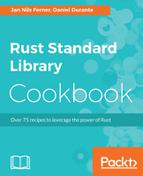Notice how this recipe looks nearly identical to the last one? Except for the structures, the only significant difference is that we called serde_json::to_string() [81] instead of toml::to_string(), and serde_json::from_str() [96] instead of toml::from_str(). This is the beauty of a well-thought-out framework like Serde: the custom serialization and deserialization code are hidden behind trait definitions and we can use the same API without caring about internal implementation details.
Other than that, there is nothing to say that hasn't been said in the previous recipe, which is why we are not going to go over any other formats. All important formats support Serde, so you can use them the exact same way you use the other formats in this chapter. For a full list of all supported formats, see https://docs.serde.rs/serde/index.html.
